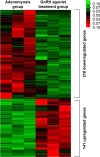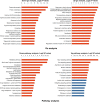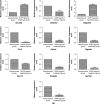Transcriptome analysis of endometrial tissues following GnRH agonist treatment in a mouse adenomyosis model
- PMID: 28331289
- PMCID: PMC5352156
- DOI: 10.2147/DDDT.S127889
Transcriptome analysis of endometrial tissues following GnRH agonist treatment in a mouse adenomyosis model
Abstract
Purpose: Adenomyosis is a common, benign gynecological condition of the female reproductive tract characterized by heavy menstrual bleeding and dysmenorrhea. Gonadotropin-releasing hormone (GnRH) agonists are one of the medications used in adenomyosis treatment; however, their underlying mechanisms are poorly understood. Moreover, it is difficult to obtain endometrial samples from women undergoing such treatment. To overcome this, we generated an adenomyosis mouse model, which we treated with an GnRH agonist to determine its effect on pregnancy outcomes. We also analyzed endometrial gene expression following GnRH agonist treatment to determine the mechanisms that may affect pregnancy outcome in individuals with adenomyosis.
Methods: Neonatal female mice were divided into a control group, an untreated adenomyosis group, and an adenomyosis group treated with a GnRH agonist (n=6 each). The pregnancy outcome was observed and compared among the groups. Then, three randomly chosen transcriptomes from endometrial tissues from day 4 of pregnancy were analyzed between the adenomyosis group and the GnRH agonist treatment group by RNA sequencing and quantitative reverse transcription polymerase chain reaction (PCR).
Results: The litter size was significantly smaller in the adenomyosis group than in the control group (7±0.28 vs 11±0.26; P<0.05). However, the average live litter size was increased (10±0.28 vs 7±0.28; P<0.05) after GnRH agonist treatment. Three hundred and fifty-nine genes were differentially expressed in the GnRH agonist-treated group compared with the untreated group (218 were downregulated and 141 were upregulated). Differentially expressed genes were related to diverse biological processes, including estrogen metabolism, cell cycle, and metabolite biosynthesis.
Conclusion: GnRH agonist treatment appears to improve the pregnancy outcome of adenomyosis in a mouse model. Besides pituitary down-regulation, other possible mechanisms such as the regulation of cell proliferation may play a role in this. These new insights into GnRH agonist mechanisms will be useful for future adenomyosis treatment.
Keywords: GnRH agonist; RNA-seq; adenomyosis; mouse; pregnancy outcome.
Conflict of interest statement
Disclosure The authors report no conflicts of interest in this work.
Figures





Similar articles
-
GnRH agonist improves pregnancy outcome in mice with induced adenomyosis by restoring endometrial receptivity.Drug Des Devel Ther. 2018 Jun 7;12:1621-1631. doi: 10.2147/DDDT.S162541. eCollection 2018. Drug Des Devel Ther. 2018. PMID: 29922037 Free PMC article.
-
Transcriptome analysis of eutopic endometrium in adenomyosis after GnRH agonist treatment.Reprod Biol Endocrinol. 2022 Jan 12;20(1):13. doi: 10.1186/s12958-021-00881-3. Reprod Biol Endocrinol. 2022. PMID: 35022045 Free PMC article.
-
The impact of GnRH agonists on endometrial immune cells in patients with adenomyosis: a prospective cohort study.BMC Med. 2025 Jun 9;23(1):338. doi: 10.1186/s12916-025-04162-3. BMC Med. 2025. PMID: 40484943 Free PMC article.
-
An update on the pharmacological management of adenomyosis.Expert Opin Pharmacother. 2014 Nov;15(16):2347-60. doi: 10.1517/14656566.2014.953055. Epub 2014 Sep 6. Expert Opin Pharmacother. 2014. PMID: 25196637 Review.
-
Uterine Adenomyosis: From Disease Pathogenesis to a New Medical Approach Using GnRH Antagonists.Int J Environ Res Public Health. 2021 Sep 22;18(19):9941. doi: 10.3390/ijerph18199941. Int J Environ Res Public Health. 2021. PMID: 34639243 Free PMC article. Review.
Cited by
-
Window of Implantation is Significantly Displaced in Patients with Adenomyosis with Previous Implantation Failure as Determined by Endometrial Receptivity Assay.J Hum Reprod Sci. 2018 Oct-Dec;11(4):353-358. doi: 10.4103/jhrs.JHRS_52_18. J Hum Reprod Sci. 2018. PMID: 30787520 Free PMC article.
-
Establishment of a novel mouse model of adenomyosis suitable for longitudinal and quantitative analysis and perinatal outcome studies.Sci Rep. 2022 Oct 20;12(1):17515. doi: 10.1038/s41598-022-22413-8. Sci Rep. 2022. PMID: 36266437 Free PMC article.
-
Hypoxia and its possible relationship with endometrial receptivity in adenomyosis: a preliminary study.Reprod Biol Endocrinol. 2021 Jan 8;19(1):7. doi: 10.1186/s12958-020-00692-y. Reprod Biol Endocrinol. 2021. PMID: 33419445 Free PMC article.
-
Animal Models of Adenomyosis.Semin Reprod Med. 2020 May;38(2-03):168-178. doi: 10.1055/s-0040-1718741. Epub 2020 Oct 26. Semin Reprod Med. 2020. PMID: 33105508 Free PMC article. Review.
References
-
- Devlieger R, D’Hooghe T, Timmerman D. Uterine adenomyosis in the infertility clinic. Hum Reprod Update. 2003;9(2):139–147. - PubMed
-
- Benagiano G, Habiba M, Brosens I. The pathophysiology of uterine adenomyosis: an update. Fertil Steril. 2012;98(3):572–579. - PubMed
-
- Ferenczy A. Pathophysiology of adenomyosis. Hum Reprod Update. 1998;4(4):312–322. - PubMed
-
- Maheshwari A, Gurunath S, Fatima F, Bhattacharya S. Adenomyosis and subfertility: a systematic review of prevalence, diagnosis, treatment and fertility outcomes. Hum Reprod Update. 2012;18(4):374–392. - PubMed
-
- Salim R, Riris S, Saab W, Abramov B, Khadum I, Serhal P. Adenomyosis reduces pregnancy rates in infertile women undergoing IVF. Reprod Biomed Online. 2012;25(3):273–277. - PubMed
MeSH terms
Substances
LinkOut - more resources
Full Text Sources
Other Literature Sources
Molecular Biology Databases

